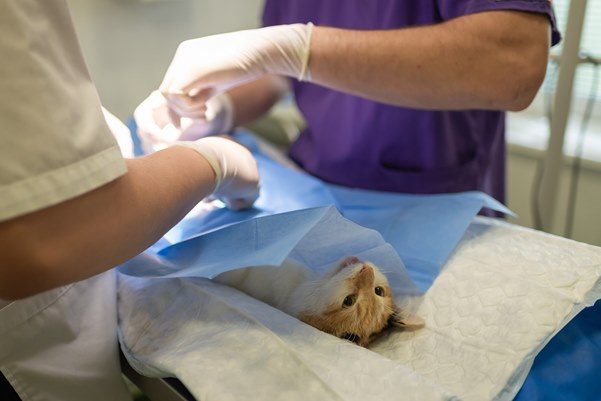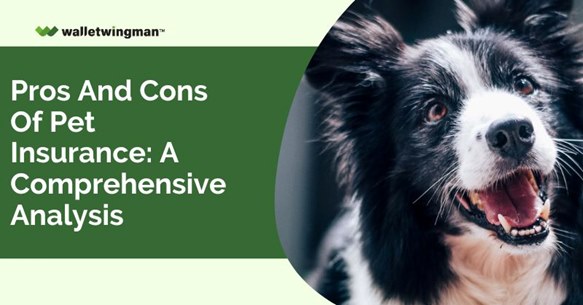According to the American Pet Products Association (APPA), 66% of U.S. households own one (or more than one pet), and considering the benefits of human-animal interaction, it’s unsurprising why.
Although pets are a valuable addition to any household, their care can be pricey, with pet owners getting a vet bill costing over $1,000 every six seconds.
Understanding the pros and cons of pet insurance is essential for every pet owner. Whether you have a dog, cat, bird, or guinea pig. Global Market Insights analysts foresee the U.S. pet market worth more than $10 billion by 2025, with a significant portion of revenue flooding into the insurance market.
You can find an affordable and tailored plan that could save you thousands of dollars if you’re concerned about high pet insurance costs. Most providers offer pet insurance for old dogs, puppies, cats, and kittens. However, some providers will also cover other animal species.
A pet insurance policy could save you money and even Fido or Felix’s life. Are you still trying to decide whether to take out coverage? Let our comprehensive analysis of the advantages and disadvantages of pet insurance guide you in the right direction.

Is Pet Insurance Worth It?
A recent Forbes Advisor report found that pet insurance costs an average of $44/month for dogs and $30 per month for cats. While this price may vary depending on the provider, pet insurance can be affordable and worthwhile. Less than $50 per month is a small price to safeguard your furry friend. And, if you read the fine print on a policy before paying, you can avoid unexpected fees and limitations later down the line.
Animal health insurance plans require the pet owner to pay monthly or annually. Pet owners receive reimbursement for veterinary expenses in exchange for regular payments, provided they meet the terms and conditions of the plan. Many policies offer pet insurance with preventative care, among many other add-ons.

How Does Pet Insurance Work?
Before the start date of a pet insurance policy, companies usually require a professional health checkup to ensure the animal is not already sick. Coverage will begin after a brief waiting period. But, the waiting period may vary from six months to one year for specific conditions. However, accident coverage waiting periods are usually just a few days.
Pet insurance coverage is available once you pay the vet bill in full. After payment, the customer files a claim using the receipt. The insurer reimburses the bill once they accept the claim. There are two ways to receive insurance payouts: by direct wire transfer or by check. With most insurers finalizing a claim in two to three business days. More complex claims could take longer.
A plan’s structure influences the reimbursement rules. Listed below are the critical elements of most pet insurance plans:
- Deductible: This is paid per year or incident before coverage starts.
- Reimbursement level: The percentage of the vet bill paid by an insurer after you pay the deductible.
- Annual max: The cut-off point your insurer imposes for paying yearly medical bills. You will be required to pay anything beyond the annual maximum.
The average cost of insurance depends on your pet’s age, the coverage you buy, and where you live. To determine the cost of pet insurance premiums, coverage providers will also examine a few other influential factors, such as pet breed, sex, lifestyle choices, food intake, and pre-existing conditions.

The Perks of Pet Insurance
Data published by the North American Pet Health Insurance Association indicates that the pet insurance sector is swelling by 20% annually. With almost half of pet insurance policy owners filing a claim yearly. This high-demand market provides peace of mind, among many other benefits.
Here are a few things to consider if you’re on the verge of taking out a policy:
1. Numerous Health Issues and Chronic Conditions are Covered
A broad scope of health complications and surgical procedures may be covered by pet insurance, such as ACL surgery, spaying and neutering, poisoning and toxicity, bowel obstruction removal, allergies, hip dysplasia, arthritis, glaucoma, skin conditions. For example – scabies and ringworm, epilepsy, diabetes, thyroid disease, urinary tract infections, prosthetic devices, alternative pet medicine, nausea and vomiting, age-related conditions.
2. Various Plans are Available
Lifetime, accident-only, accident and illness, wellness coverage, maximum benefit, annual, and comprehensive are the main types of pet insurance.
3. Pet Insurance Can Help Pay for Routine Vet Visits
Routine veterinary care is included in most plans, such as vaccinations, pet wellness checkups, and dental cleanings.
4. Add-ons
Pet health insurance and life insurance policies are customizable according to your needs. Common endorsements that join with an existing plan include coverage for exam fees, microchipping, deworming, routine checkups, or prescription food.
5. You Can Improve Your Pet’s Health and Quality of Life
A healthy pet is happy. Plus, interacting with a happy pet can increase the feel-good chemicals dopamine and serotonin levels in your brain, so everyone wins!
6. Pet Insurance Coverage Can Provide You With Peace of Mind
You will feel at ease knowing that your pet insurance policy will cover the costs of unexpected vet trips. If you are avoiding spending money on pet insurance, you will likely face financial difficulty and stress if an accident happens. If you don’t take out coverage and your pet falls seriously ill, finding the funds for treatment may be troublesome, and your pet’s future may be jeopardized.
7. Multiple Pets Can Join a Single Policy
Do you have many canine and feline friends living in the family home? Seek out the top pet insurance companies for multiple pets. Some providers specialize in multi-pet discounts.
8. You Maintain the Freedom to Choose Your Preferred Veterinarian
If you wonder, “Do all vets take pet insurance?” you’ll be pleased to know that all licensed veterinarians will accept pet insurance.
9. Payment Plans Are On Offer from Many Providers
Paying in installments is possible if your vet has a payment plan or collaborates with a third-party lender.
10. Insurance Coverage May Be Valid When Overseas with a Pet
Only some providers will allow their customers to file a claim while overseas. Still, if you cater your search correctly, you will find some providers offering out-of-country coverage.
11. Reimbursement for Property Damaged By Your Pet
Third-party liability insurance is a type of pet insurance that covers the cost of pet-caused damage to someone else’s property.
12. Advertising and Reward Costs
On the rare occasion that your dog is lost or stolen, specific providers can cover the reward price. Moreover, if your dog is lost far away from home. Pet insurance providers may accommodate your circumstances by paying for temporary accommodation.

The Downsides of Pet Insurance
Some pet owners may feel reluctant to purchase pet insurance simply because of the market’s associated cons. Like any other type of insurance policy, pet insurance has its downsides. Making yourself aware of the following potentially negative aspects of pet health insurance is essential when deciding if a policy is right for you:
- Pet Insurance Can Burn a Hole in Your Wallet – The high cost of many pet insurance policies explains why this is one of the best-paying jobs in the life insurance industry.
- Upfront Costs Are Required Before Coverage Begins – If you find a provider offering swift coverage, your options will only be available once you have paid up front. A plan typically requires at least one month’s payment.
- Policies for Older Pets are Limited and Pricey – A pet insurance policy should be taken out while our pet is still young. Older pets are more susceptible to disease and health problems, meaning providers will turn you away or charge high premiums.
- Finding a Reliable Pet Insurance Provider Can Be Tricky – A quick search on the web will generate thousands of pet insurance providers. Making an informed decision when taking out a pet insurance policy requires research.
For example, find out what customers are saying by reading reviews and checking star ratings. It’s also a good idea to find out how long the provider has been in business and confirm their AAHA accreditation.
- Coverage is Exempt for Pre-existing Conditions – If your pet already has a mild or severe medical condition, you can apply for coverage, but you won’t receive reimbursement for treatment for the pre-existing condition(s
- You Might Not Get Your Money’s Worth – If your pet doesn’t get sick or injured, you won’t be able to file a claim and use the coverage you pay for monthly or annually.
- Your Cover May Change – Pet insurance providers can make changes when you renew annually. Including premium increases, coverage caps, added exclusions, and reduced payment limits.
- Some Insurers Don’t Cough Up The Money Quickly – Long waiting times are standard among pet insurance providers. So, pay attention to customer reviews if you want to find a policy payable without delay.
Conclusion
With the rising cost of living and markets trending in a southerly direction. It’s essential to ask yourself: how would you handle a situation where your pet had an unanticipated $1,000 (or more) vet bill? Despite your best efforts, life can be unpredictable, and it is your job to nurse your four-legged (or two-legged) friend back to health.
To minimize out-of-pocket costs each time an incident arises, seek pet insurance plans with a high reimbursement level, high annual maximum, and low deductible. Although the monthly fee for low-deductible pet insurance policies will usually be higher than a high-deductible plan, the money-saving benefits will be worthwhile.


 7 Best-Paying Jobs In Life Insurance And How To Land Them
7 Best-Paying Jobs In Life Insurance And How To Land Them  10 Highest-Paying Life Insurance Jobs You Can Consider In 2023
10 Highest-Paying Life Insurance Jobs You Can Consider In 2023 